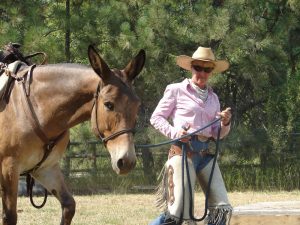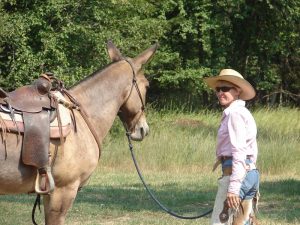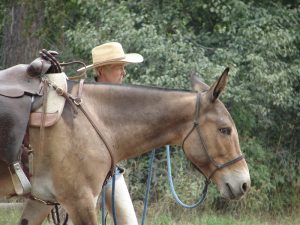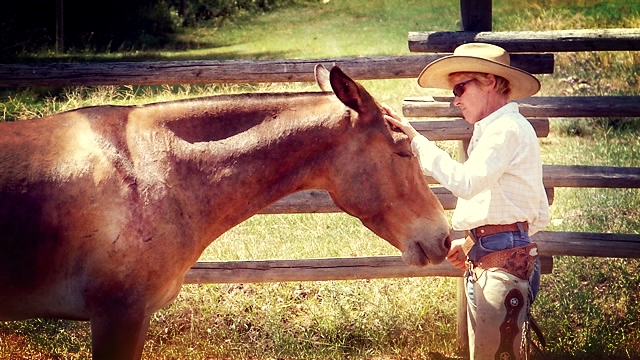Online Exclusives
Laurie Warren, Banjo the mule, and Harry Whitney’s clinics
Laurie Warren, owner of Warren’s Mule Training Center in Council, Idaho (www.muleteacher.com), takes a unique approach to her mule training business. Aside from working her clients’ mules at her home facility, Laurie also uses them as her “personal mounts” where they receive additional attention during frequent travels to a variety of destinations. The mules in her care often trek into country like the high desert, the beach, mountainous regions, and some years even the back country of Alaska.
 When compared to horses, it is well known that mules present people with their own unique brand of challenges. As the adage goes, “A mule is like a horse only more so.” What that really means may be as much a mystery as the mules themselves. However, there is little doubt that to be an effective mule trainer one must have a little “more so” herself to meet the specific challenges the long eared equines present. With 20 years of successful mule training backing her, Laurie has quite a bit of “more so” to carry on the work of starting young mules and sorting out mule problems for clients.
When compared to horses, it is well known that mules present people with their own unique brand of challenges. As the adage goes, “A mule is like a horse only more so.” What that really means may be as much a mystery as the mules themselves. However, there is little doubt that to be an effective mule trainer one must have a little “more so” herself to meet the specific challenges the long eared equines present. With 20 years of successful mule training backing her, Laurie has quite a bit of “more so” to carry on the work of starting young mules and sorting out mule problems for clients.
“I love the mules because I like their personality,” Laurie says. “I think they are safer in the mountains—they take care of themselves therefore they take care of you because they have a strong sense of self-preservation, which is what makes them so hard when things go south. They’re all about saving their own skin. They learn so fast and they try so hard for you. They will give you their heart and soul and do everything for you. And I love the challenge. I do the same thing over and over starting colts, but each one is a little bit different and I scratch my head a lot.”
The range of challenges that mules present keeps the work interesting for Laurie. She enjoys helping the mules in her care improve in many ways and feel better about their interactions with people, and she likes to explore a variety of perspectives on horsemanship. To this end, Laurie has hauled mules to different horsemanship clinics over time and hosted some mule clinics herself. A few years ago, she was prompted by friend to attend a Harry Whitney clinic. As a result, Harry’s clinics have become favorites of hers with their engaging discussions and Harry’s somewhat unique approach that focuses on working with horses’ (and mules’) thoughts.
Recently she trailered one of her mules-in-training, Banjo, to Harry’s annual clinic in Stevensville, Montana to participate as a rider.
 “What I love about going to Harry is I get to look at it [mule issues] from a different person’s point of view,” Laurie says. “Get some feedback from him because I respect him so much and he thinks differently from how I do. I started [Banjo], and he was fairly typical—had a lot of fear; came around really nice; started riding him. But when I took him outside he was pretty nervous.”
“What I love about going to Harry is I get to look at it [mule issues] from a different person’s point of view,” Laurie says. “Get some feedback from him because I respect him so much and he thinks differently from how I do. I started [Banjo], and he was fairly typical—had a lot of fear; came around really nice; started riding him. But when I took him outside he was pretty nervous.”
The mules Laurie trains for clients typically are used as trail mounts, and Banjo fell into this category. Laurie says she likes to start working with saddle mules in the round pen and the arena, but as soon as possible she begins riding them out in the open country.
“I’d probably gotten five rides on Banjo outside and he was pretty worried the first time I took him where there was heavy trees,” Laurie says. “It just so happened that some cattle were turned out in this area. We were in the wide open and he was watching the cows. We got into the heavier trees and Banjo got nervous.”
During the early stages of working on riding a mule away from the confines of a corral Laurie has her niece who works for her ride along. The niece rides a more seasoned mount and often ponies another mule along while Laurie rides the green mule.
“Usually having another horse [or mule] along is enough to give them the confidence to get through things,” Laurie says. “Banjo started getting nervous.”
Laurie rode Banjo down the trail but the mule went on high alert. She stopped when the mule spotted two cows across the river.
 “He was looking at them and I got him to move forward again,” Laurie says, “and then right below us down in the trees another cow walked out and he blew up. That left him with residue that he was really scared riding outside [the corral]. That’s why I picked him to take to the clinic, because he’s just looking for something in the bushes every time I take him outside. Even when you take him out and try to pony him he’ll try to leave you and run away when he gets scared.”
“He was looking at them and I got him to move forward again,” Laurie says, “and then right below us down in the trees another cow walked out and he blew up. That left him with residue that he was really scared riding outside [the corral]. That’s why I picked him to take to the clinic, because he’s just looking for something in the bushes every time I take him outside. Even when you take him out and try to pony him he’ll try to leave you and run away when he gets scared.”
At the clinic, Banjo stayed close to other horses in outside pens in an open pasture. The round pen was near a barn with a wooded area to one side. Leading Banjo to the round pen before a session was enough to greatly increase his apprehension, Laurie says.
“Harry just tutored me to get his mind with me more and to help get him focused,” Laurie explains. “I wasn’t getting it quite done and Harry came in there and he was clear and got a change in that mule. Oh, that mule tried so hard for him. When Harry was working with Banjo, Banjo was trying so hard but he was scared. Harry said, ‘This mule is giving us everything he’s got.’
“I think what I learned in the round pen that first morning was to accept those little tries that they give you—acknowledge them more than I do. Harry basically worked with him on the softness and getting him to stay mentally with you and forget about worrying about what was outside of the round pen.”
Banjo was not in a horrible state when they began their session that day, Laurie recounts. Rather, his mind was wayward just enough to produce some moderate worry.
 “It’s not that he wasn’t with me, because I was able to work him,” Laurie says, “but he wasn’t with me 100 percent. And Harry came in, got big, and got him with him mentally, and then the mule came over and just dropped his head and was there. The next day I came in there and was working on more advanced things, and Harry had me ride on a slack rein, pick up a rein, and wait for the thought to come across. Harry had me working on that softness with Banjo, riding him and just waiting for that thought every time I picked up a rein.
“It’s not that he wasn’t with me, because I was able to work him,” Laurie says, “but he wasn’t with me 100 percent. And Harry came in, got big, and got him with him mentally, and then the mule came over and just dropped his head and was there. The next day I came in there and was working on more advanced things, and Harry had me ride on a slack rein, pick up a rein, and wait for the thought to come across. Harry had me working on that softness with Banjo, riding him and just waiting for that thought every time I picked up a rein.
“Banjo…that mule just relaxed and got soft and made such a mental change that Harry opened up the gate and I was working on the outside of the arena too. Every time he’d get worried I’d just pick up that rein and tip that thought and bring him back to me mentally and that mule just went from being worried to so relaxed.”
Another major moment at the clinic for Laurie and Banjo occurred after some work in the arena. One end of the arena was near a wooded area and Banjo was very nervous to go near it.
“We got to the point where I could go down there riding softly with a slack rein and just pick up his thought and get him to stay with me mentally and then we went outside,” Laurie says. “It was so cool because everybody left but Linda [Davenport] just happened to be there and I unsaddled Banjo and I went and put him away in his pen. Normally he’d go get a drink—it was pretty hot—and he’d go to eat, but I put him in there and he followed me back to the gate. I was standing there latching the gate and he just dropped his head right at my chest level and he was just so soft and so peaceful and centered, and he just came to me for that. Linda saw it…I don’t know what he was saying to us but I guess a ‘thank you’ for that clarity that he got from that lesson. I’ve had softness and I’ve had him want to be with me before, but this was different. This was even more so. That mule just felt so good inside. That was such a big change for the mule that day.”
Laurie is back home now with Banjo. The mule is technically “done,” but Laurie says she continues to work with him off the clock because she wants to keep these changes solid and get them even better.
“I’ve been working on the same softness with taking him outside of my arena and keeping those thoughts with me,” Laurie says. “And pushing that further and further because outside of my arena we’ve got pasture and I’ve got a river and there are trees. I’ve taken him out there and ponied him and that’s where he gets worried. I’ve noticed since we came back there’s a softness in there—a confidence that I didn’t have before the four days in Montana. And it’s just because he’s feeling better inside.”
Another change Laurie has noticed since she began Harry’s clinics is her own appreciation of auditing. She placed no value in auditing clinics before meeting Harry and only attended ones where she could ride. But with Harry, she says she sees great value in watching him work and taking in the lessons he provides from coaching on others.
“It’s such a better way for the horses and the people,” Laurie says of Harry’s horsemanship, “but you have to be willing to want it—that relationship with your horse, to make it a better deal for them and know that they’re going to feel good. But there’s no free lunch in this. It takes a lot of work and time and dedication to get it. You’ve got to put a lot of work into yourself to get that and to recognize that and to get your skill level up there.”


